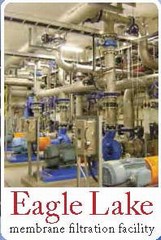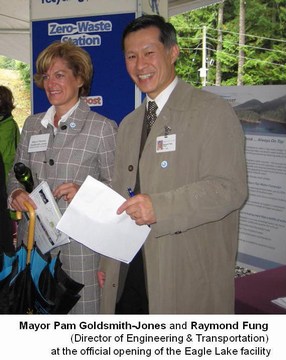Eagle Lake membrane filtration facility reduces West Vancouver’s reliance on Metro Vancouver regional water
The Spring 2009 issue of Watermark Magazine includes a feature article on the District of West Vancouver's Eagle Lake Water Treatment Plant.
 Until recently, only chlorination had been used for water treatment. The District recognized that additional treatment was required to protect the public from pathogens, colour and turbidity. In 2009, a state-of-the-art membrane filtration technology was completed. It provides protection against waterborne diseases and the possible impacts of turbidity, while reducing the amount of chlorine used. The treatment process also includes pH adjustment to the naturally acidic source waters.
Until recently, only chlorination had been used for water treatment. The District recognized that additional treatment was required to protect the public from pathogens, colour and turbidity. In 2009, a state-of-the-art membrane filtration technology was completed. It provides protection against waterborne diseases and the possible impacts of turbidity, while reducing the amount of chlorine used. The treatment process also includes pH adjustment to the naturally acidic source waters.
To download a copy of the article, click on Eagle Lake membrane filtration facility. Watermark Magazine is published by the British Columbia Water & Waste Association (BCWWA). For more information about the project, click on Eagle Lake Membrane Filtration Facility Backgrounder.

About West Vancouver
Located on the foot of Hollyburn Mountain, West Vancouver is a waterfront community spanning 89 square kilometres. It is bordered by Howe Sound to the west, the Capilano River to the east, and the Coast mountains to the north. The municipality’s population is about 45,000.
The District supplies potable water to the residents from three sources – two are owned and operated by the District; the third is a bulk water connection to Metro Vancouver. As the primary municipally operated supply, Eagle Lake has been used as a potable water supply since the 1920s. The lake is situated at 483 metres elevation, adjacent to Cypress Provincial Park, and is contained within a natural coast woodland environment.
Posted June 2009

